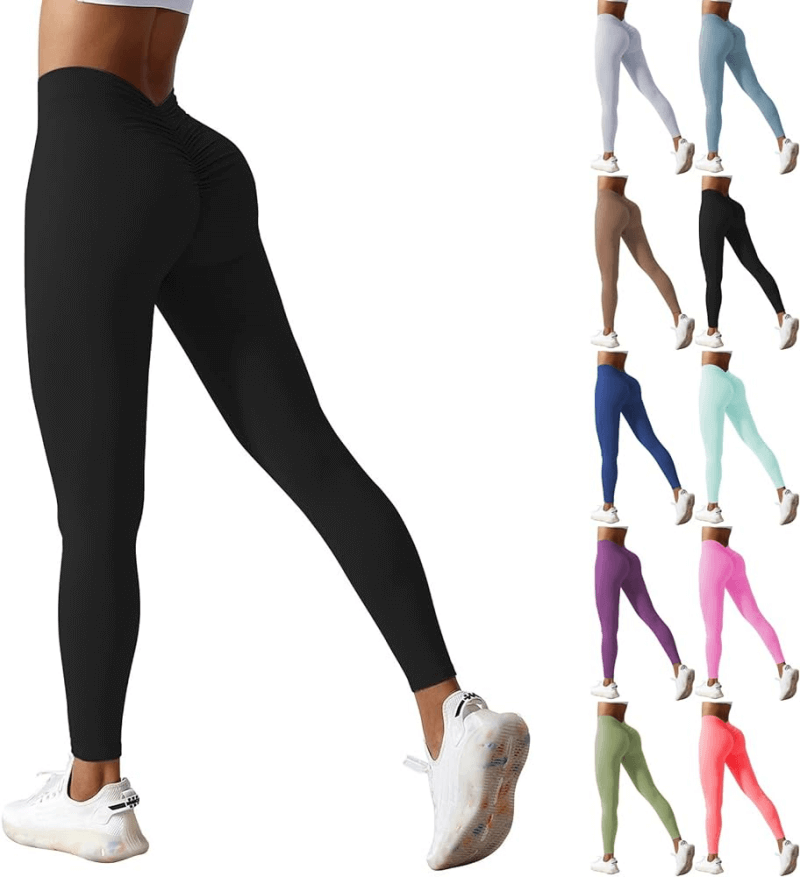As a result of their ease, flexibility, and fashionable appearance, yoga pants have become an indispensable component of both athletic and casual wardrobes. On the other hand, the choice of materials that are utilized in the building of yoga pants has a considerable impact on the performance of these trousers. The purpose of this article is to investigate the numerous materials that are typically utilized in the production of yoga pants, as well as the specific qualities of these materials and how they influence the overall performance of the garment. When customers and producers have a thorough awareness of the available material options, they are better able to make selections that aim to improve comfort, durability, and functionality.

Material Components That Are Used in Yoga Pants Cotton
Cotton is a natural fiber that is known for its suppleness and breathability, and it is also known for providing good comfort. On the other hand, its moisture-wicking properties are restricted, and it has a tendency to retain sweat, which makes it less appropriate for strenuous workouts.
Because of its toughness, moisture-wicking qualities, and quick-drying features, polyester is a synthetic material that is commonly utilized in the production of sporting apparel. It is common practice to combine polyester blends with different fibers in order to improve stretch elasticity and comfort.
Another popular synthetic fabric, nylon is renowned for its strength, suppleness, and resistance to abrasion. Another common synthetic fiber is nylon. Given that it is not only lightweight but also possesses excellent moisture-wicking capabilities, it is an excellent choice for high-performance yoga trousers.
Spandex (Lycra/Elastane): Spandex is a key component in yoga trousers on account of its ability to provide stretch and flexibility. The majority of the time, it is combined with other fibers in order to improve the garment’s elasticity and guarantee that it will keep its shape after being stretched.
Fabric made from bamboo is lauded for its inherent antibacterial capabilities, as well as its softness and breathability. Bamboo is a material that is becoming increasingly popular in the market for athletic wear. In addition to this, it is kind to the environment, which contributes to its allure.
Modal is a type of rayon that is noted for its softness, breathability, and drape. It is created from the pulp of beech trees and belongs to the cotton family. For the purpose of improving the comfort and functionality of yoga trousers, it is frequently combined with other types of fibers.
Aspects of Performance That Are Affected by the Selection of Materials
Comfort is the most important aspect to consider while purchasing yoga pants. Natural fabrics such as cotton and bamboo are known for their softness and breathability, whilst synthetic fibers such as polyester and nylon are known for their ability to give a snug fit and regulate moisture. Spandex-containing blends ensure that the trousers stretch and move with the body, which increases the level of comfort experienced when performing a variety of yoga poses.
Moisture-Wicking: It is essential to have an efficient moisture management system in place in order to experience comfort when working out. Polyester and nylon are two examples of synthetic fibers that are very effective at wicking moisture away from the body and drying off quickly. This eliminates the possibility of chafing and irritation, as well as the collection of sweat, which would otherwise occur.
Durability: The durability of the materials used in the construction of yoga pants is a factor that determines how long they will last. Because of its strength and resistance to abrasion, nylon and polyester are typically used for high-intensity exercises because of their suitability for such activities. The combination of these fibers with spandex assures that the pants will be able to tolerate repeated stretching without having their shape altered.
The ability to stretch and be flexible is a requirement for yoga trousers since it enables the wearer to go through their complete range of motion. Spandex is the essential material that is responsible for providing the required stretch. To what extent the fabric blend is flexible is directly proportional to the percentage of spandex that it contains. In general, a blend that has 10–20 percent spandex provides the best possible stretch and healing ability.
Breathability: Breathability is essential for maintaining a comfortable feeling and regulating the temperature of the body. Cotton and bamboo are examples of natural textiles that are exceptionally breathable, allowing air to circulate and heat to escape at the same time. Recent developments in synthetic fibers have resulted in an increase in the breathability of these materials, which has made them appropriate for high-performance yoga trousers.
Sustainability: As concerns about the environment continue to grow, the sustainability of materials has emerged as an important factor to take into consideration. When compared to conventional cotton and synthetic fibers, bamboo and organic cotton are chosen because they have a smaller impact on the environment. The use of recycled polyester as an environmentally friendly alternative is also gaining popularity.

Blends of Materials and the Advantages They Offer
The utilization of the strengths of each individual material is maximized when several fibers are combined in a single fabric blend. This results in a garment that possesses balanced performance characteristics.
Cotton-Spandex Blends: These blends, which combine the stretch and shape retention properties of spandex with the suppleness and breathability of cotton, are very desirable. It is possible that they do not possess the moisture-wicking capabilities that are necessary for strenuous exercises, but they are perfect for relaxed yoga sessions and everyday wear.
Blends of polyester and spandex: These blends provide durability, properties that drain away moisture, and properties that dry quickly, in addition to the stretch that is required for complete flexibility. They are appropriate for more strenuous forms of yoga as well as other types of physical exercises.
Nylon-Spandex Blends: Known for their strength, elasticity, and moisture control, these blends are great for performance-focused yoga pants. Not only do they offer a snug fit, but they are also able to withstand rigorous movements and repeated use.
Bamboo-Spandex Blends: The combination of the inherent softness and antibacterial characteristics of bamboo with the elasticity of spandex results in yoga trousers that are comfortable, breathable, and environmentally responsible. When it comes to consumers who are concerned about both performance and sustainability, these are great.
mixes of Modal and Spandex: These mixes provide remarkable softness and drape, in addition to the elasticity that spandex provides. In addition to ensuring flexibility and comfort during yoga practice, they provide the impression of being the most luxurious.
Applications and Considerations That Are Commonly Used
Practicing Yoga in a Casual Manner: Convenience and breathability are the most important factors to take into account when it comes to casual yoga practices. Blends of cotton and bamboo are good because of their natural feel and the fact that they are soft. Each of these materials offers sufficient stretch and flexibility, making them suitable for light yoga poses as well as regular wear.
Intense Workouts: Yoga classes that are performed at a high intensity require materials that are superior in terms of their capacity to wick away perspiration, dry quickly, and stay durable. Combinations of polyester and nylon that contain a large amount of spandex are appropriate for use in these circumstances. In addition to ensuring that the wearer remains dry and comfortable, they are able to fulfill the requirements of strenuous movements.
solutions That Are Friendly to the Environment Bamboo and recycled polyester blends provide environmentally conscious consumers with sustainable solutions that do not compromise performance. The use of these materials helps to lessen the impact on the environment while also providing the functionality that is essential for yoga practice.
Yoga pants that are made to be worn throughout the day should strive to strike a balance between comfort, durability, and style. There are a number of fantastic options available, including modal and cotton mixes with spandex. These materials offer a supple texture, breathability, and flexibility, which makes them appropriate for yoga sessions as well as other casual activities.
Final Thoughts
The materials that are used to make yoga pants have a considerable impact on their performance. These materials can have an effect on aspects such as comfort, moisture management, durability, flexibility, breathability, and sustainability. Both consumers and manufacturers are able to make educated decisions that will maximize the functionality and durability of yoga pants if they have a thorough understanding of the characteristics and advantages of various fibers and the blends of those fibers. In order to satisfy the ever-evolving requirements of yoga practitioners and fitness enthusiasts, the discovery and use of novel materials will be of critical importance. This is because the need for high-performance and environmentally friendly sportswear is expected to continue to increase.











